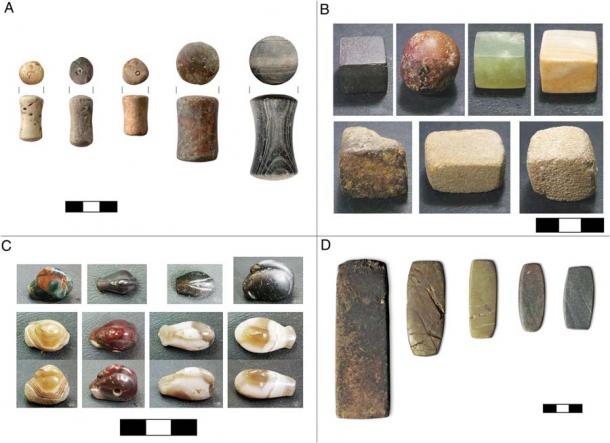Spool-shaped weights recovered from Bronze Age Greece have been found to weigh about the same as similar artifacts discovered in Europe and the Middle East. While the researchers working on this project say 3,000-year-old ancient weights “may have sparked Europe’s first free market,” others say that ideas of an international weights and measures system “fit a little too well into our modern neoliberal discourse.”
Standard weights and measures are maintained by modern laws, but Bronze Age merchants also needed them for buying and selling goods. While traditional archaeologists hold that weights and measures were set and maintained by ruling authorities, a new study suggests merchants in Bronze Age Europe operated a network and weight system beyond the control of kings and ruling warlords.

The weight system under analysis is thought to have enabled continental trade more than 3,000 years ago. ( alfaysal360 / Adobe Stock)
Weighing Up the Evidence for an International Weights and Measures System
Archaeologists Lorenz Rahmstorf and Nicola Ialongo from Georg August University of Göttingen spent nearly a decade analyzing ancient weights dating back 3,000 years from sites in Europe, Anatolia, and Mesopotamia. Their new study, published in PNAS, discusses Bronze Age Mesopotamia and how merchants established informal networks of standardized weights and measures. This weight system, they claim, later spread across Europe enabling continental trade more than 3,000 years ago.
Standard weights and measures emerged in Egypt or Mesopotamia 5,000 years ago. European graves dating to 3,000 years ago have been found with “bone balance beams, tweezers for picking up scraps of gold or silver, and stone weights,” according to the new paper. The team analyzed 2,000 artifacts that weighed between 8 and 10.5 grams (0.28 to 0.37 ounces) that were excavated in the 5,000-kilometer stretch (3,107 miles) between Great Britain and Mesopotamia.

The team compared Bronze Age balance weights and weight systems from Greece, India, Iran and Italy. ( Ialongo et. al / CC BY-NC-ND 4.0 )
Tipping the Scales
In Mesopotamia, the standard unit was the shekel, about which researcher Dr. Ialongo told Hareetz “weight systems in Europe were only slightly different from weight systems in Anatolia,” – which in turn were only slightly different than the shekel system of ancient Mesopotamia. In the new paper the researchers suggest that in all of these areas of ancient trade and commerce “it was merchants who kept the weights standard, because it was in their interest to do so” and not the monarchies and ruling dynasties, as historians have always assumed.
According to an article in Science Mag , for more than 100 years historians have assumed that weight standards were “handed down from on high, first created by a king or religious authority to collect taxes or tribute, then later adopted by merchants. But this is all being challenged by the paper. Dr. Ialongo “speculated” that every time ancient traders met they used their own scales and standard weights, which were compared, then passed onto new traders. Preferred standards emerged over time from Great Britain to Babylon and the “weight units were regulated by the market.”

The research study assessed the propagation of error in this continental weight system by making 100 replica stone weights. (Ialongo et. al / CC BY-NC-ND 4.0 )
Weighing in On Modern Neoliberal Discourse in Archaeology
Testing this hypothesis, co-author and archaeologist Raphael Herman replicated a Bronze Age bone balance scale and he made 100 replica stone weights. The telephone game proves that when humans copy or replicate something, errors are made that get amplified the longer something is copied. Because each of the new weights was modeled randomly from the weights already produced, human error, combined with the slight imprecision of the ancient balance, led to deviations of “up to 25 grams (0.88 ounces) from the original 153-gram (5.4 ounce) weight.” When these results were analyzed, “the pattern matched the distribution of the ancient samples”.
Archaeologist Christopher Pare from the Johannes Gutenberg University of Mainztold told Hareetz that the new research helps clarify how far-flung Bronze Age societies traded across long distances. However, he and others say we must show caution “applying modern economic concepts to the distant past.” Traditionally, archaeology has presented a picture of the past in which all powerful tribal rulers and kings called the shots, but since the mid-20th century, revisionist or progressive archaeologists have tried to rewrite that narrative to suit what is now known as “Marxist archaeology”.
All evidence points to ancient societies, including their weights and measures, being managed by kings, who also controlled the taxes which resulted from these measurement standards. Christopher Pare says the idea of the market standardizing itself “fits a little too well into our modern neoliberal discourse.” Essentially, he means we shouldn’t really be using terms like “free market stabilization” when describing two men with camels meeting at an oasis to swap spices.
Top image: Spool-shaped Bronze Age weights from Tiryns in Greece. Source: Ialongo et. al / CC BY-NC-ND 4.0
By Ashley Cowie
 RSS Feed
RSS Feed















 June 30th, 2021
June 30th, 2021  Awake Goy
Awake Goy  Posted in
Posted in  Tags:
Tags: 













